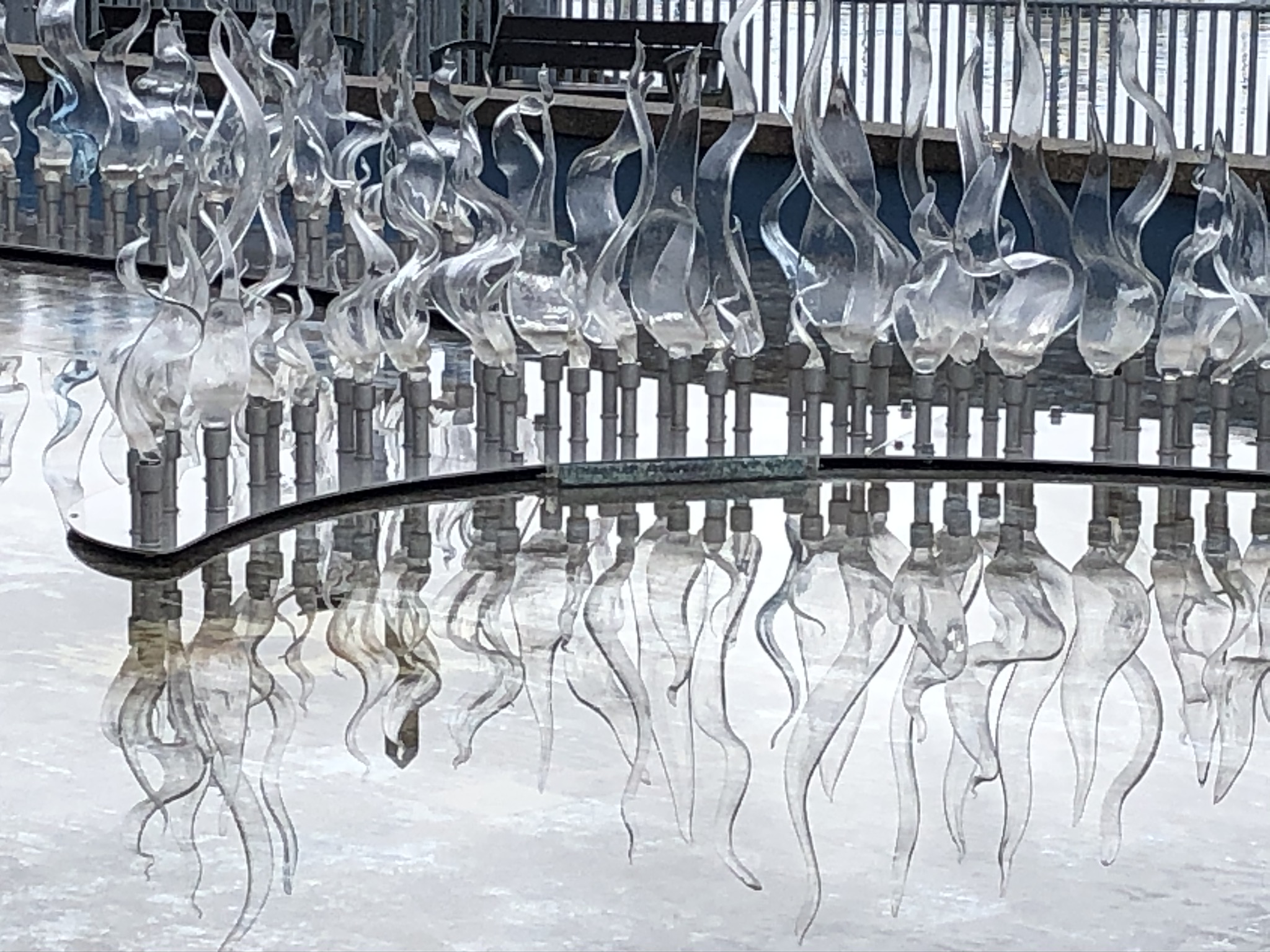“The only dream worth having is to dream that you will live while you are alive, and die only when you are dead. To love, to be loved. To never forget your own insignificance. To never get used to the unspeakable violence and vulgar disparity of the life around you. To seek joy in the saddest places. To pursue beauty to its lair. To never simplify what is complicated or complicate what is simple. To respect strength, never power. Above all to watch. To try and understand. To never look away. And never, never to forget.”
― Arundhati Roy The Cost of Living (1999)
If it weren’t for that pesky number at the end of the quote, dating it some 20 years back, you might as well imagine that Arundathi Roy crafted that paragraph with an eye on the exhibition currently on display at the Oregon Historical Society, DREAMs Deferred.

Roy frequently writes about the fate of minorities, refugees or displaced people on the Indian subcontinent. The focus of the DREAMs Deferred exhibit is somewhat closer to home, asking what happens to those who came to our country from Mexico or Latin America as young children of undocumented parents. The collaborative work on display shows a combination of six portraits and short-form narrative accounts of young undocumented immigrants, joined by photographic documentation of some treasured objects that were chosen by them be taken on the hazardous journey. The thrust is indeed: Watch! Try and understand! Never look away! These are your neighbors. These are people who just like the rest of us seek love, overcome obstacles and indescribable challenges, pursue a simple life and do not confuse the things that matter with those that should be ignored.


The dream, the aspiration, is to live while you’re alive – something not guaranteed in the places that were left behind, with often existential threat forcing parents to bring their children to an unknown country that then was not known for its hospitality if you were non-white and poor, and is even less so today. DREAMERS, as these young people are known, existed in a legal limbo until the Obama administration in 2012 announced the DACA (Deferred Action for Childhood Arrivals) policy, which brought a pause to potential deportation if you qualified. You had to be younger than 16 upon arrival to the US, lived here (endless documentation needed) for at least five years, be between 15 and 30 year old and either in school, or graduated, or a veteran of the Army or the Coast Guard, and have no convictions for felonies, significant misdemeanors (DUI included) or multiple misdemeanors. (Here is a small window into the insane bureaucracy involved for (re)application.)

Approximately 700.000 people were protected by DACA until the Trump administration decided to rescind the policy in 2017. Their fate rests now with the US Supreme Court, with cases to be decided this June. Add to that the fate of 250.000 offspring of those Dreamers, who are US citizen because they were born here, but would be separated from their parents if deportation ensued. The Supreme Court cases also reach potentially beyond those young people now involved and living in limbo – there is the distinct possibility that any future President will be denied the right to implement progressive immigration reform through executive action. (Legal details can be found here.)

*
The small, beautifully curated exhibition provides an intimate window into the lives, thoughts and emotions of six very different undocumented people from Mexico and South American countries, made possible with support from the Zidell Family Foundation. The concept was developed by The Immigrant Story (TIS,) a local non-profit organization which is playing an important and increasingly visible role in capturing our attention about the plight of those in our community who do not have the legal protections the rest of us enjoy. “The right to have rights,” to use Hannah Arendt’s phrase from “The Origins of Totalitarianism (1951), is, after all, restricted to citizens, and according to the United Nations, there are a record 65.6 million people who have been forcibly displaced; 22.5 million are considered refugees; ten million people currently stateless, all deprived of basic rights you and I take for granted.
Folks at TIS, guided, pushed, prodded and supported, if my intuition is correct, by founder and Board president Sankar Raman, understand the persuasive power of narrative relative to the value of statistics. If you aim for empathy and inclusion, as their mission statement implicates, storytelling is essential. Trained as a physicist, Raman holds a Ph.D. in Engineering and retired from the High Tech industry some years back, with an arsenal of skills when it comes to the technical challenges of organizing multi-pronged, group-based work. He arrived in the US from India in the beginning of the 1980s, just as I arrived from Germany. Given our similarity in age and comparable levels of education, I could not but wonder, while in conversation with this passionate man, how the difference in the color of our skin affected the process of immigration and integration.

*
By the time you leave the exhibition you have become if not familiar, then somewhat connected to those who shared their thoughts, joys and fears. Partly that has to do with the quality of the portraits, photographed by Raman. Larger-than-life faces all with eyes directed straight at the viewer express a range of emotions across subjects. Whistfulness alternates with exuberance, pensiveness with caution. There is a naturalness to them, even though they are obviously staged, that speaks to both the skill of the photographer and, more importantly, to the trust established between artist and subject. There is a poise that reveals these young people know that what they are doing is important. Telling their stories cannot be an easy thing even for the more gregarious among them. The use of a color palette focused on optimism rather than foreboding also draws you in. Strong work.

*
“Strong work” is probably the weakest of the descriptors used in evaluation of photographer Jim Lommasson’s output. He is something of a role model if not a hero to many local and national photographic artists both for the quality of his workmanship and the choice of subject matters. A demonstrably humble man, he likely grimaces at such a label, but that is how the community sees him. As does the jurying set who decides to award grants and prizes, including the Dorothea Lange-Paul Taylor Prize (2004) a coveted recognition from the Center for Documentary Studies at Duke University.

Lommasson does not shy away from difficult topics, or political discourse transmuted into emotionally charged images and text. The artist somehow manages to communicate the raw essence of his subjects, their suffering and their triumphant survival no matter where he directs his lens. From American boxing rings, to the postwar existence of wounded veterans of the Iraq and Afghanistan wars, to documentation of mementos of generations of Holocaust and genocide survivors in his most recent project: What we carried: Fragments from the Cradle of Civilization, the work invites us to think about our shared humanity. Us and hundreds of thousands of viewers nationally, given that his work has been displayed at numerous museums, including the Ellis Island Immigration Museum, which alone has half a million visitors come through on an annual basis.

Invite is perhaps the wrong term. Lommasson forces us to engage with the images, objects – in the DREAMs Deferred display as well – that were selected by those who had to leave home, not just because of their poignancy, captured without any sentimentality in the photographs. We are forced to engage because of the platform given to the voices of those who carried these objects into the unknown: the images provide the surface on which the explanatory narratives unfurl, in the handwriting of the refugees.


I forget where I picked this up, but the artist from the very start of his career as a photographer was motivated by a child’s question on viewing (bland) images: “So what?” Not for a moment does his documentary work afford this sentiment. No “So what?” possible in the presence of the anguish, grit and will towards survival in his depictions. Lommasson’s desire to show that at the core we are all one, in our vulnerability, in our hopes, in our rights to have rights, finds the perfect expression in his art. In this focus he reminds me of Anjum, the central character in Arundathi Roy’s newest novel The Ministry of Utmost Happiness, who lives in a deserted Muslim graveyard just outside New Delhi. She is able to make borders disappear between men and women, animals and humans, life and death. As the author herself (approximately) put it in her PEN America Arthur Miller Freedom to Write lecture last May – we turn to people like these when seeking shelter from the tyranny of hard borders in an increasingly hardening world.

*
How would it feel, if you were ripped out of your teenage universe at age 15, mourning the loss of the all-important cohort, forced to study in a foreign language and live in a foreign country, constantly worried about your ability to put down some roots? What would it take to have great academic success while fearing you will be denied access to college? And now, less than a decade after your arrival, you own a flourishing practice as a family therapist, helping, among others, Spanish speaking clients to deal with the existential strain of displacement, or the hardship of living with uncertainty? Liliana Luna, who I met at the exhibit opening, can tell you all about it.


How would one cope if being sent back to a country that you last saw as a toddler? Having to leave a close-knit community of co-workers in case of deportation, evidenced by many of the OMSI staff who came to the exhibit opening to celebrate their colleague? Miguel Rodriguez is out of the woods in this regard, having been granted legal status.



Given his work in the community through his non-profit engagement at Through a Latinx Lens, he would be able to tell you, however, countless stories of those out there living in constant fear of what the future holds. Dreams deferred, indeed.
It is upon all of us to make sure they do not shrivel, fester, or explode.

DREAMs Deferred: January 10 – April 12, 2020
Oregon Historical Society
1200 SW Park Ave
Portland, Oregon 97205
There will also be a Live event at Lincoln Recital Hall, Portland State University 1620 SW Park Avenue, Portland OR 97201.
Saturday, April 11, 2020. 7 p.m. to 10 p.m.
DREAMs Deferred Live kicks off at 7 p.m. with a culturally specific musical performance from this region. Afterward, from 8:30 p.m. to 10:00 p.m., six different storytellers from Mexico and Central America will share unique stories about the arduous and frequently dangerous journeys that brought them across the border to the United States.















































































































































































